| |
Orders of Architecture
In the fine arts, Greece surpassed all contemporary nations, and it may not be too much to add, all that have flourished since; and the monuments, which yet remain in its ancient cities, form the best models for imitation to the artists of the present time. The Greeks were the parents of that system of architecture, which was afterwards adopted and modified by the Romans, and from these two nations we derive the greater part of our scientific terms, the chief of which we will now particularize.
The Orders in architecture are five; Tuscan, Doric, Ionic, Corinthian, Composite.
The Romans employed all the five Orders; the Greeks only three, Doric, Ionic, Corinthian. The parts essential to form an Order, are the Column, and its Entablature; the Pedestal is an accessary.
The Pedestal is divided into three principal parts, the base, the die, and the cornice.
The Column is divided into three; the base, the shaft, and the capital.
The Entablature is divided into three; the architrave or epistylium, the frieze or zophorus, and the cornice.
These are again subdivided into smaller members, called mouldings, the regular forms of which are eight in number.

1. Fillet or Annulet, (Annulus), used to separate the others.
2. Astragal.
3. Torus, used to bind the column.
4. Cyma-reversa, or Ogee (as supports).
5. Ovolo (as supports).
6. Scotia.
7. Cyma-recta (as coverings).
8. Cavetto (as coverings).
Tuscan Order
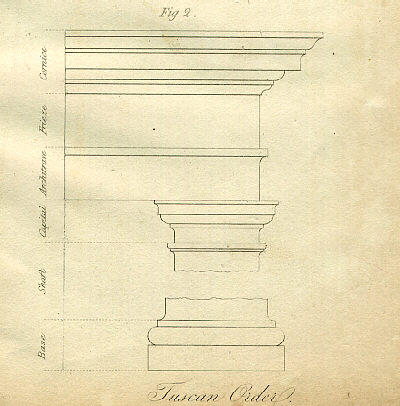
The Pedestal, when used, is very plain.
The Base includes the fillet.
The square block under the Torus is termed the Plinth.
The Shaft is attached to the fillet of the Base by a hollow, called Apophyge, (greek) the upper fillet and astragal form part of the Shaft, the curve of union with these mouldings and the shaft is called Apothesis,.
The Shaft is never fluted.
The Capital consists of the necking and mouldings, crowned with a square block, Abacus, (greek), and a fillet.
The Architrave has a fascia and a tenia.
The Cornice has a flat face called a Corona, or Larmier, (the under side of which is the soffit or plafond), the mouldings under it are termed bed-mouldings; the fillet above the Corona belongs to it; and the cyma-recta and the fillet above it, are called the Cymatium.
Grecian Doric Order
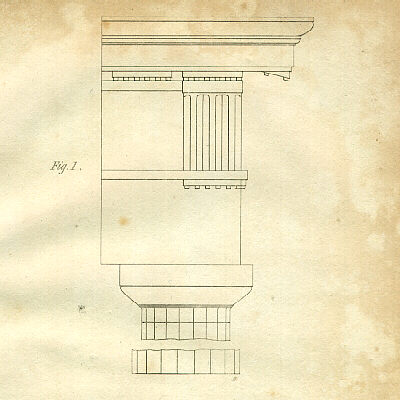
This Order is generally used without a pedestal, always without a base. The Shaft has mostly twenty flutes. A sinking (channelure) under the necking (hypotrachelion). The Capital consists of small annulets, an echinus, and an abacus. In the frieze the edge of the triglyph which consists also of the femur, is placed on the exterior angle; the metopes are not square; the capital of the triglyphs belongs to the frieze. In the cornice are mutules with guttae over the triglyphs and metopes; the cymatium often has lions' heads placed along the cyma-recta or echinus, and used as water-spouts.
Roman Doric Order
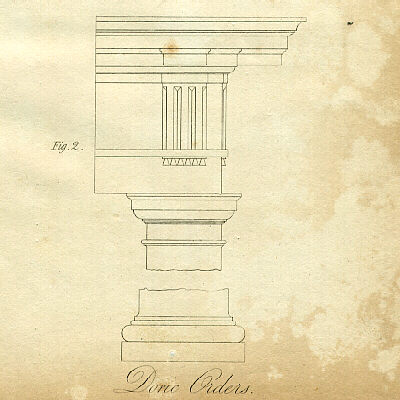
This Order has sometimes a pedestal, a base, with a plinth and other mouldings; the fillet in this and the remaining Orders belongs to the shaft. The shaft is sometimes cut with twenty flutes, (striges).
The necking of the capital is often adorned with roses and husks.
The Architrave has a fascia with a tenia, the small fillets under the tenia are each termed a regula, the drops under the regula, guttae. The frieze is enriched with triglyphs, the centre of which must be over the centre of the column, the metopes must be square, and may be filled with ox-skulls and paterve.
The Cornice has the capital of the triglyphs; and a flat band with mutules, which are square, one over each triglyph.
| |
Grecian and Roman Ionic Orders
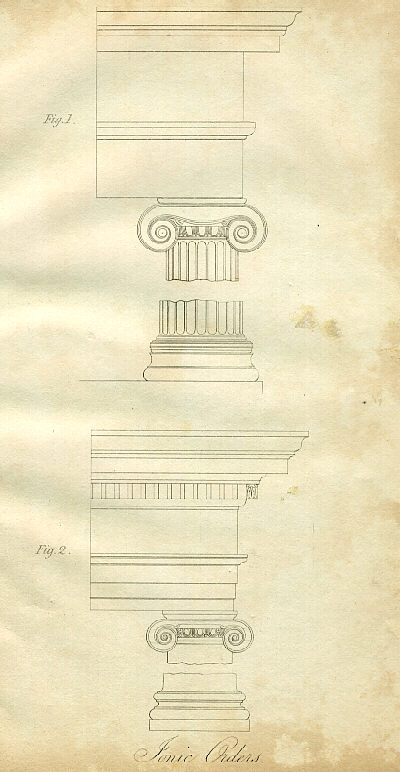
To these Orders pedestals may be used, and bases always.
The shafts are often cut with twenty-four flutes with fillets (striæ) between them.
The principal distinguishing feature of these Orders is the Capital, having four spiral projections, called volutes. In the Grecian these were placed flat on the front and back of the column, leaving the two opposite sides to form what is called a balustre: the hem is the projecting spiral fillet, the sunk part is the channel, the centre of the spiral, the cathetus. In the Roman they were often placed in the same manner. The Greeks frequently placed an angular volute on the front exterior angle, showing one flat and one angular volute to each exterior face, and a balustre to each interior. The Romans also used four angular volutes, with the sides of the abacus arcs of circles.
The astragal at the top of the shaft is called by the Italians, fusarolo, or fuse.
The cornices were often enriched with dentils, small flat faces with narrow spaces cut between each, on a dentil band, and used in the bedmouldings.
Grecian and Roman Corinthian
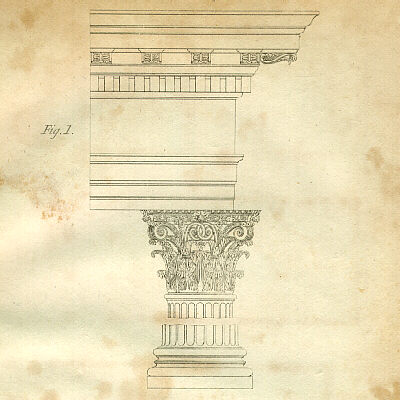
These Orders may have a pedestal, and always a base; the shafts fluted as the Ionic the capitals consist of a bell, (campana or corbeille), surrounded with two rows of leaves, eight in each row; the abaci are formed concave on each side, with the exterior angles taken off, called the horns; the angular volutes spring from the caulicoli, and are supported on a row of leaves; on each side, in the centre, are two smaller spirals, called (helices or urillae). The cornices have dentils, and also modillions carved, with a balustre in front, and a scroll with leaves on the sides.
Composite Order
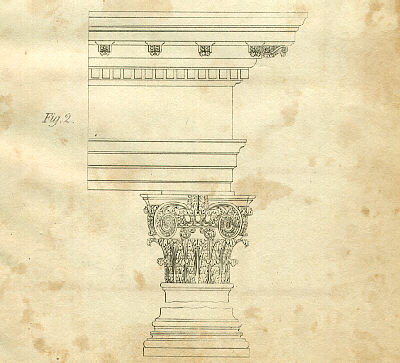
This Order may have a pedestal, base, and shaft, as the Corinthian. The capital has two rows of leaves, with four large angular volutes springing from the ovolo, and an abacus, as in the angular Roman Ionic capital. The cornice has modillions or blocks, flat on the front and side faces; in other respects it is similar to the Corinthian.
In all the Orders the shafts of the columns are regularly diminished towards the top; but sometimes they have a swelling. The flutes in the Ionic, Corinthian, and Composite Orders, are sometimes filled to about one third of their height with a round moulding; this is called cabling.
The metopes in the Doric frieze, and the friezes in the Ionic, Corinthian, and Composite Orders, are often ornamented with sculptured figures and foliage.
The Frieze in the Ionic Order is sometimes swelled, it is then called a pulvinated frieze.
A Fascia, face, or band, is any broad flat member.
Entablatures are sometimes supported by male figures, called Persians, Atlantides, or Telamones; or by female figures, Caryatides; or by busts placed upon a trunk, (vagina), called termini.
At the exterior angles of walls, and behind columns, are used what the Greeks called antæ; they are flat; the width of the upper diameter of the columns, never fluted; the bases differ from those of the columns, and the capitals are always composed of horizontal mouldings. In Roman architecture these are called pilasters ; they diminish, and have the same bases, flutes, and capitals, as the columns with which they are used.
The projection of any moulding before the face of the one below it, is called the Ecphora.
| |
|